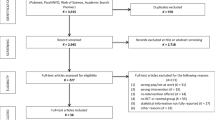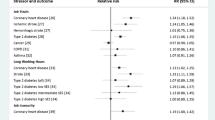Abstract
Objectives
The number of elderly workers has also been increasing and poor psychological well-being in elderly workers has been reported. The aim of this study is to elucidate the factors that are related to poor psychological well-being in elderly workers.
Methods
We administered General Health Questionnaire-12 (GHQ-12) as an indicator of psychological well-being to 330 male elderly workers in the age range of 50–69, and analyzed different psychological factors, namely sense of coherence (SOC), and physical and lifestyle variables such as blood pressure, serum total cholesterol, smoking frequency, alcohol intake, exercise frequency, and body mass index (BMI) that are related to GHQ-12.
Results
When the cut-off point of GHQ-12 was 2/3, 97 workers who showed high GHQ-12 score were classified as one group having poor psychological well-being. A statistically significantly lower SOC score, higher stress score, lower frequency of exercise, higher smoking score and higher BMI, but not longer working hours or higher shift work score in the workers with higher GHQ-12 scores were observed than in the workers with normal GHQ-12 scores. Multiple logistic regression analysis showed that the low SCO score, low frequency of exercise, high smoking frequency and high BMI significantly contributed to the high GHQ-12 score.
Conclusions
A low SOC score in elderly workers is assumed to be directly related to poor psychological well-being, or via the development of lifestyle problems such as lack of exercise, obesity, and smoking in elderly workers. This assumption must be confirmed by conducting future intervention studies on lifestyle.
Similar content being viewed by others
References
Rix SE. Rethinking the role of older workers: promoting older worker employment in Europe and Japan. Issue Brief (Public Policy Inst (Am Assoc Retired Pers)). 2005;IB77:1–32.
Borrell C, Muntaner C, Benach J, Artazeoz L. Social class and self-reported health status among men and women: what is the role of work organisation, household material standards and household labour? Soc Sci Med. 2003;44:1869–1887.
Harma M, Kandolin I. Shiftwork, age and well-being: recent developments and future perspectives. J Hum Ergol (Tokyo). 2003;40:287–293.
Nakamura H, Ogawa Y, Nagase H, Nakajima M, Kodama N, Ogino K, et al. Natural killer cell activity and its related psychological factor, sense of coherence in male smokers. J Occup Health. 2001;43:191–198.
Nakamura H, Matsuzaki I, Sasahara S, Hatta K, Nagase H, Oshita Y, et al. Enhancement of a sense of coherence and natural killer cell activity which occurred in subjects who improved their exercise habits through health education in the workplace. J Occup Health. 1999;46:278–285.
Kivimaki M, Kalimo R, Toppinen S. Sense of coherence as a modifier of occupational stress exposure, stress perception, and experienced strain: a study of industrial managers. Psychol Rep. 1998;83:971–981.
Hurrell JJ, McLaney MA. Exposure to job stress—a new psychometric instrument. Scand J Work Environ Health. 1988;14 Suppl 1:27–28.
Sauter SL, Murphy LR, Hurrell JJ. Prevention of work-related psychological disorders. A national strategy proposed by the National Institute for Occupational Safety and Health (NIOSH). Am Psychol. 1990;45:1146–1158.
Amick BC, Celentano DD. Structural determinants of the psychosocial work environment: introducing technology in the work stress framework. Ergonomics. 1991;34:625–646.
Millar JD. Mental health and the workplace. An interchangeable partnership. Am Psychol. 1990;45:1165–1166.
Doi Y, Minowa M. Factor structure of the 12-item General Health Questionnaire in the Japanese general adult population. Psychiatry Clin Neurosci. 2003;17:379–383.
Fuchino Y, Mizoue T, Tokui N, Ide R, Fujino Y, Yoshimura T. Health-related lifestyle and mental health among inhabitants of a city in Japan. Nippon Koshu Eisei Zasshi. 2003;116:303–313. (Article in Japanese)
Horige Y. A Japanese version of the Health Locus of Control Scales (in Japanese). Kenko Shinri Kenkyu. 1991;4:1–7.
Wallston KA, Wallston BS, DeVellis R. Development of the Multidimensional Health Locus of Control (MHLC) Scales. Health Educ Monogr. 1978;6:160–170.
Yamazaki Y. SOC, a theory on salutogenesis and health promoting ability from newly developed view points for health. Quality Nursing. 1999;5:824–832. (Article in Japanese)
Dahlin L, Cederblad M, Antonovsky A, Hagnell O. Childhood vulnerability and adult invincibility. Acta Psychiatr Scand. 1990;82:228–232.
Cohen S, Kamarck T, Mermelstein R. A global measure of perceived stress. J Health Soc Behav. 1983;24:385–396.
Cohen S, Tyrrell DA, Smith AP. Psychological stress and susceptibility to the common cold. N Engl J Med. 1991; 325:606–612.
Goldberg DP. The Detection of Psychiatric Illness by Questionnaire. A Technique for the Identification and Assessment of Non-psychotic Psychiatric Illness. London: Oxford University Press; 1972. p. 21.
Dyck RJ, Bland RC, Newman SC, Orn H. Suicide attempts and psychiatric disorders in Edmonton. Acta Psychiatr Scand Suppl. 1988;32:64–71.
House A, Knapp P, Bamford J, Vail A. Mortality at 12 and 24 months after stroke may be associated with depressive symptoms at 1 month. Stroke. 2001;13:696–701.
Yasuda N, Mino Y, Koda S, Ohara H. The differential influence of distinct clusters of psychiatric symptoms, as assessed by the general health questionnaire, on cause of death in older persons living in a rural community of Japan. J Am Geriatr Soc. 2000;30:313–320.
Irie M, Asami S, Ikeda M, Kasai H. Depressive state relates to female oxidative DNA damage via neutrophil activation. Biochem Biophys Res Commun. 2003;8:1014–1018.
Huppert FA, Whittington JE. Symptoms of psychological distress predict 7-year mortality. Psychol Med. 1995;48:1073–1086.
Ezoe S, Morimoto K. Behavioral lifestyle and mental health status of Japanese factory workers. Prev Med. 1994;23:98–105.
Atlantis E, Chow CM, Kirby A, Singh MF. An effective exercise-based intervention for improving mental health and quality of life measures: a randomized controlled trial. Prev Med. 2004;39:424–434.
Yamada Y, Kameda M, Noborisaka Y, Suzuki H, Honda M, Yamada S. Comparisons of psychosomatic health and unhealthy behaviors between cleanroom workers in a 12-hour shift and those in an 8-hour shift. J Hum Ergol (Tokyo). 2001;30:399–403.
Antonovsky A. The life cycle, mental health and the sense of coherence. Isr J Psychiatry Relat Sci. 1985;22:273–280.
Antonovsky H, Sagy S. The development of a sense of coherence and its impact on responses to stress situations. J Soc Psychol. 1986;126:213–225.
Antonovsky A. The structure and properties of the sense of coherence scale. Soc Sci Med. 1993;36:725–733.
Antonovsky A. The moral and the healthy: identical, overlapping or orthogonal? Isr J Psychiatry Relat Sci. 1995;32:5–13.
Flannery Jr RB, Perry JC, Penk WE, Flannery GJ. Validating Antonovsky’s Sense of Coherence Scale. J Clin Psychol. 1994;50:575–577.
Bernstein J, Carmel S. Trait anxiety and the sense of coherence. Psychol Rep. 1987;60:1000.
Flannery Jr RB, Flannery GJ. Sense of coherence, life stress, and psychological distress: a prospective methodological inquiry. J Clin Psychol. 1990;46:415–420.
Takayama T, Asano Y, Yamazaki Y, Yoshii K, Nagasaka Y, Fukada J, et al. Sense of coherence, stressful life events and psychological health. Nippon Koshu Eisei Zasshi. 1999;49: 965–976. (Article in Japanese)
Author information
Authors and Affiliations
Corresponding author
Rights and permissions
About this article
Cite this article
Matsuzaki, I., Sagara, T., Ohshita, Y. et al. Psychological factors including sense of coherence and some lifestyles are related to general health questionnaire-12 (GHQ-12) in elderly workers in Japan. Environ Health Prev Med 12, 71–77 (2007). https://doi.org/10.1007/BF02898152
Received:
Accepted:
Issue Date:
DOI: https://doi.org/10.1007/BF02898152




